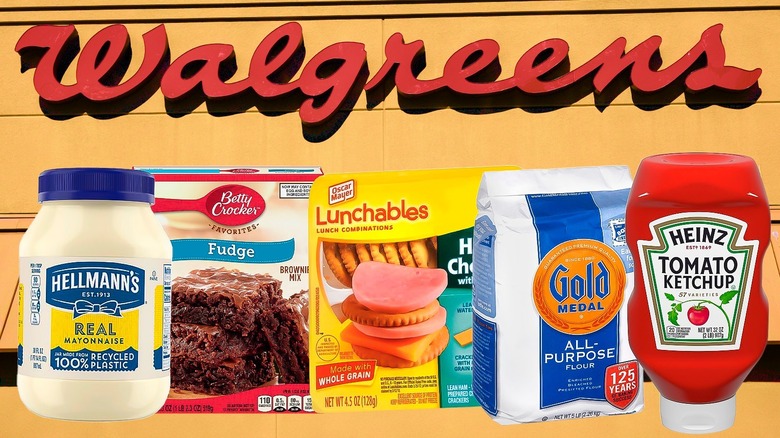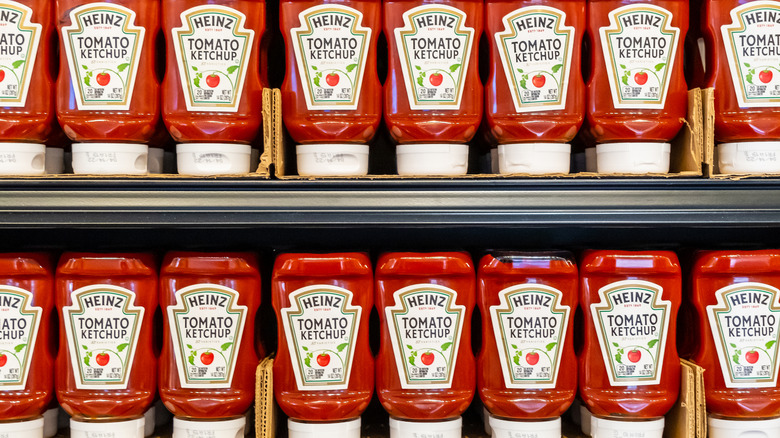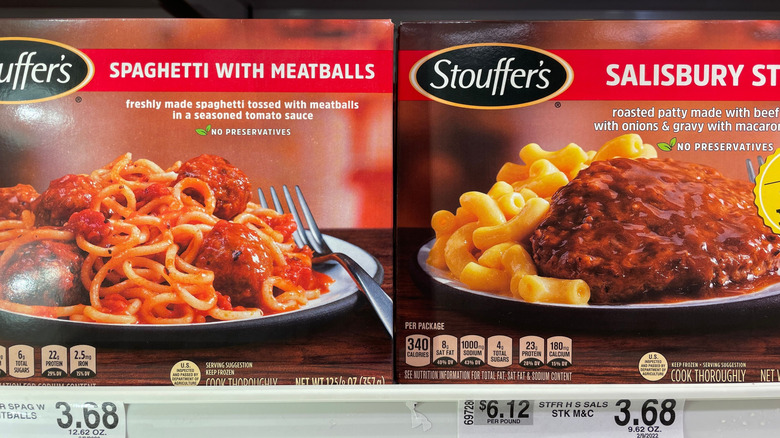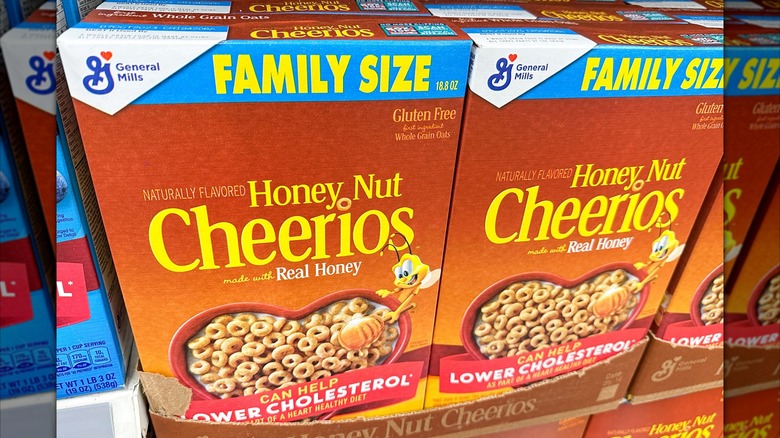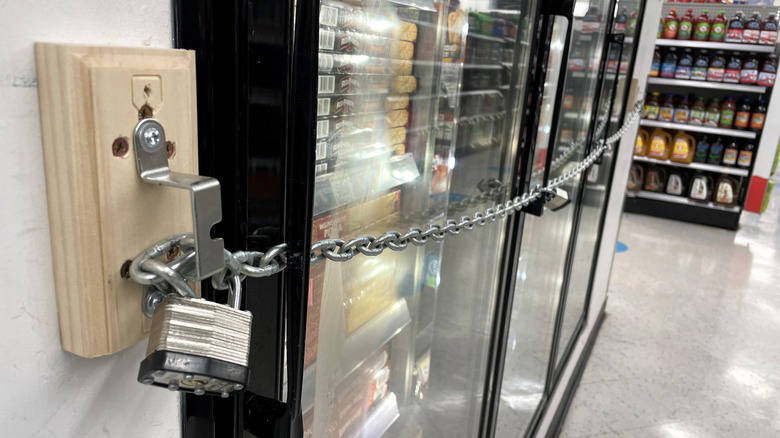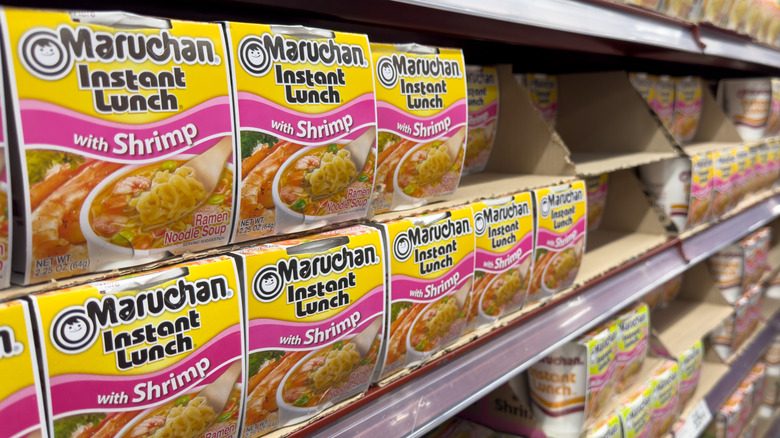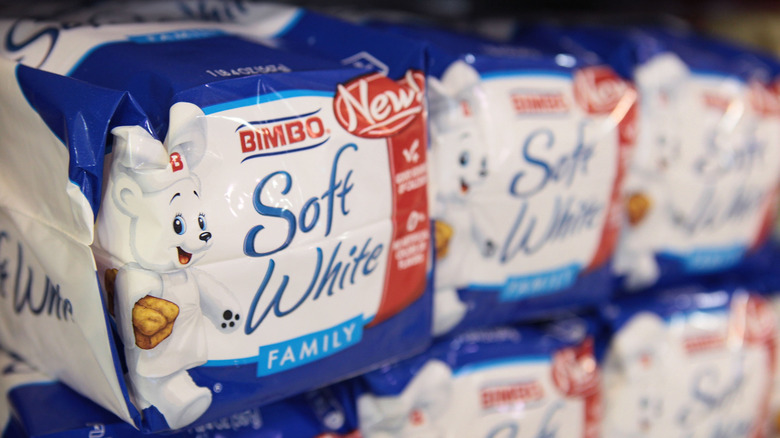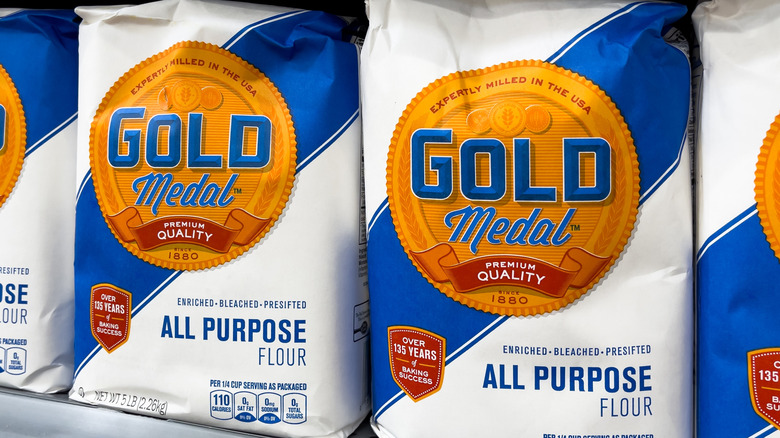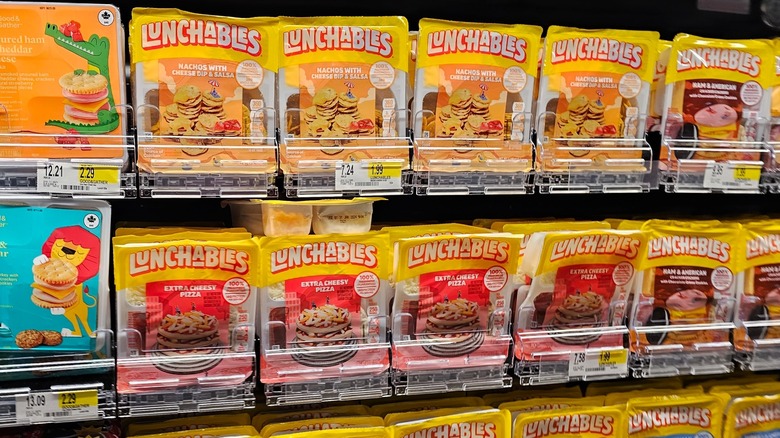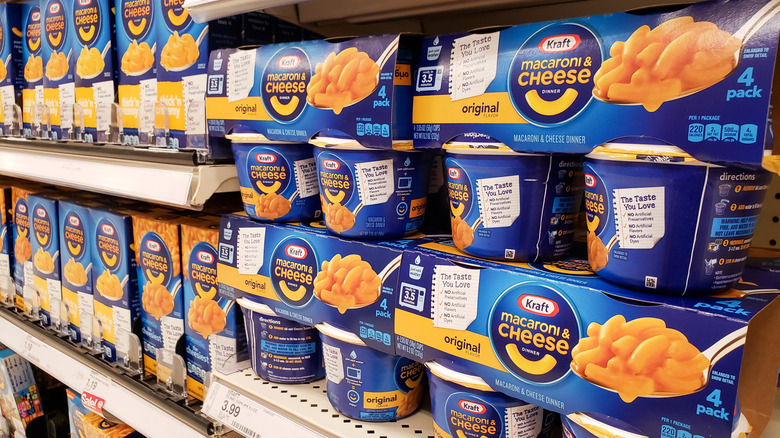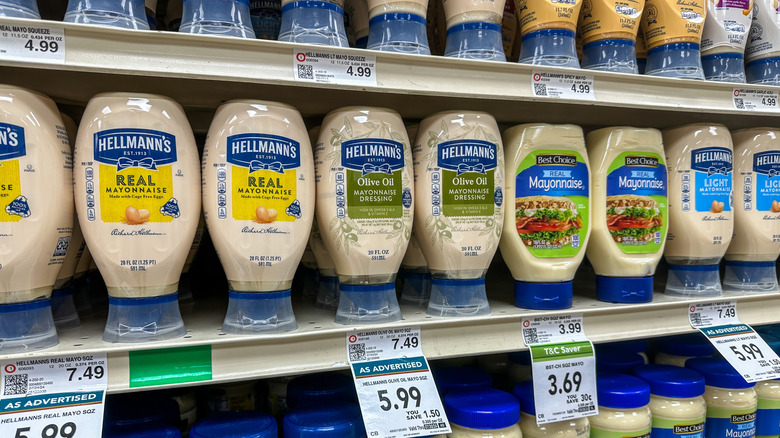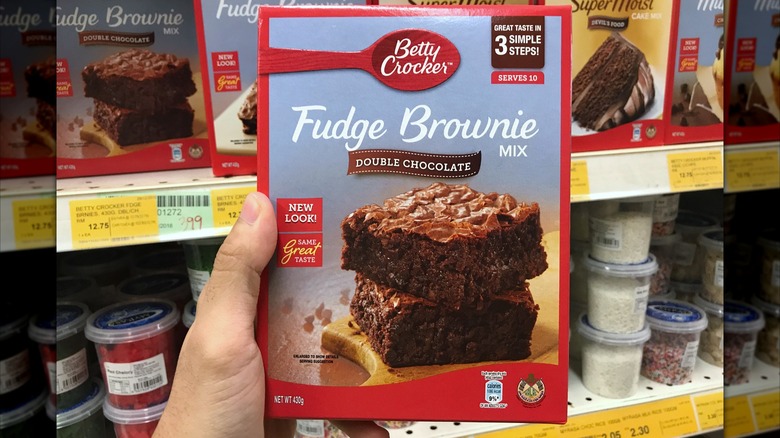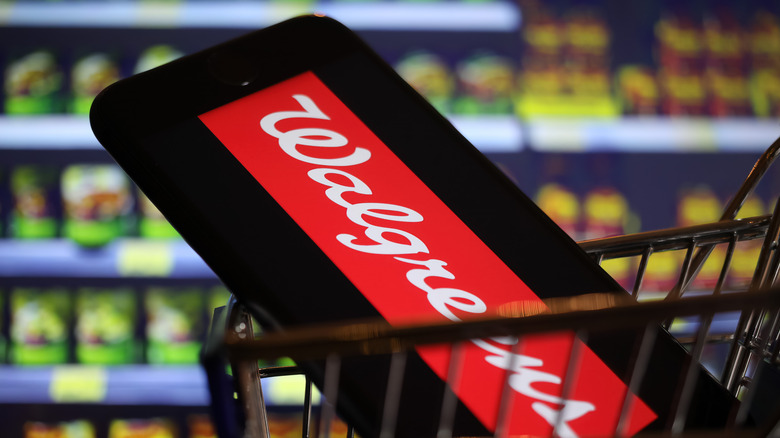11 Foods You Should Absolutely Never Buy At Walgreens
There are a few foods you should never buy at Walgreens, as tempting as it is. Imagine that you're cooking dinner, but there's just one missing ingredient. Making a quick run to the pharmacy chain seems like the best answer. It's closer to your home than any major grocery store and you can make a purchase in under five minutes. Walgreens is smaller than behemoths like Meijer where it feels like half a mile to walk to the milk section at the back of the store. Buying your ingredient at Walgreens could cost around double as picking it up at Aldi or Walmart. So, it's worth your while to drive further, walk longer, fill up a cart, and purchase groceries at a major supermarket chain — you'll spend way less. Try to avoid those last-minute runs to Walgreens at all costs and your pocketbook will thank you.
There's a second reason to avoid shopping at the pharmacy — most of the food there is highly processed and with oodles of sugar and fat. The majority of Walgreens locations don't sell fruit, veggies, or raw protein. Even though the freezers have pizza and Stouffer's dinners, you probably won't find bags of peas or fillets of fish. Junk food is the term that most aptly describes the stock here — it will fill your belly, but it won't nourish your body the same way as healthier fare would. That makes going to a grocery store even more attractive.
1. Heinz Ketchup
Ketchup is expensive at Walgreens and the alluring displays there may trick you into buying additional items you don't need. Picture this, you're making hot dogs and realize the bottle's almost empty just as you're about to set the meal on the table for your kids and playdate visitors. Heading a few blocks down the street to the pharmacy seems like the best option, even if a 32-ounce bottle of ketchup has a price tag of around $7 there. Buying the same bottle at Target costs around $4.50. Kroger sells it for $5, and Walmart for $4 when it's on sale. Under pressure, you're most likely not paying attention to price.
Maybe you don't mind spending between $2 and $3 more for the condiment because you value convenience. That's valid, but just know you probably won't walk out with only ketchup in your bag. While you're at Walgreens, you'll grab a couple of chocolate bars for dessert and a bottle of soda for the car ride home. What about a pack of gum? You might even pick up that cute coloring book by the register — you know your daughter will love it even though she already has a stack she still needs to work through. By the time you walk out of Walgreens, you've spent $20. Not only have you shelled out more money than you expected, but you may have contributed a significant amount of sugar to your diet and some clutter to your home.
2. Stouffer's single-serving meals
You're on a work trip and bunked up in a hotel for a few days. You're planning on getting around 10 Stouffer's dinners from Walgreens on the next block to get through the week. Your room has a kitchenette with a mini fridge and microwave, so the single-serve dinners seem just about perfect. It's cheaper than eating out and they don't make much of a mess. Picking them up at the chain pharmacy seems comfortable because you don't know your way around this city to a grocery store yet and you don't want to navigate the public transportation system.
Finding out where that supermarket is, or making a quick online purchase to be delivered to your hotel, could save you around $15. Each Stouffer's dinner at Walgreens costs about $1.50 more than at Walmart. The meatloaf, spaghetti, and Salisbury steak dinners are about $5 versus around $3.50. Mac and cheese is about $4.50 at the pharmacy, but only $3 at Walmart. A Stouffer's bowl of fried chicken and mashed potatoes sells for $5.50 at the first store, but about $4 at Kroger when it's on sale. Even worse, if you buy your frozen dinners at Walgreens, you're stuck with picking from the small selection of about five options, whereas most other grocery stores have a far wider variety of high-quality frozen entrées. You could even pick up a few apples for between-meal snacks at Walmart or Kroger, but won't find those at most Walgreens.
3. Cheerios
Cheerios and Honey Nut Cheerios are two of the most popular cereals in the U.S. So, if you've run out of them and it's time for breakfast, you might think about running out to Walgreens for a box, but they'll cost you dearly. Spending more might be better than hearing your kid gripe about having to eat Grape Nuts, though — "It's torture!" and "No fair!" and "You don't really love me, do you?" No one wants to start their day that way.
The ring-shaped cereal, honey-flavored or not, costs around $7.50 for an 18.8-ounce box at the pharmacy. Walmart, on the other hand, sells the same size box of either variety for about $5 normally, and close to $4.50 when there's a sale. That's a difference of between $2.50 and $3 for each box you buy. That might make it worth it to put up with a few days of complaining from the kiddos until you go on your weekly grocery run. Then, you can stock up on a bunch of boxes at a time and prevent cereal scarcity from ever happening in your home again. Eating Grape Nuts for two or three days never killed anyone, but you sure don't want to hear any more whining about it.
4. Chained up ice cream and pizza
Grabbing some ice cream and pizza from the freezer at Walgreens may give you a headache — depending on where you live chains could make it inconvenient, and then some brands are also significantly more expensive. New Yorkers and San Franciscans are the most likely to have to ask a Walgreens employee to unlock goodies for them. This store policy came about because shoplifters were emptying the freezers every night at some locations. For paying clients, it adds extra time and hassle to a quick, late-night snack run. You have to find an employee and wait for them to open the freezer and get your product. If you're wearing your pajamas, though, you may not be in the mood to talk to anyone or select what you want to eat under someone else's watchful eye. Open freezers and self-checkout look more attractive under those circumstances.
You'll notice a big price difference between Walgreens and other supermarkets for frozen pizza and ice cream. For example, Red Baron classic crust pepperoni costs less than $5 at Walmart, but around $7 at Walgreens. Then, a pint of Ben and Jerry's costs around $4.50 at Walmart. Walgreens sells it for $6 a pint and that's on sale. The regular price is closer to $7. If you're feeling particularly hungry or hanging with a big group of friends, heading to the supermarket could save you quite a bit.
5. Ramen
If you buy ramen noodles at Walgreens, you'll find that they cost nearly double what they do at the grocery store. Twice the price doesn't always seem like much because this product is already so cheap. So, spending $1 on an individually wrapped Maruchan soup cup or $.70 on a package of Maruchan noodles doesn't feel like much. Yet, you can buy the same product elsewhere for half the money. Single Maruchan soup cups cost just over $.50 at Walmart and if you purchase a six-pack, they're slightly cheaper. A package of noodles costs about $.30 at the same grocery store.
Walgreens inflated prices add up quickly if you put several packages of ramen in your cart. If you think of paying for 10 cups or packages, the difference is more noteworthy. You probably feel more strongly about spending $10 on soup cups when you could spend just $5 or $7 versus $3 for packages of noodles. If these are products you are likely to consume even though you know instant ramen is bad for you, you will benefit from buying them from a larger supermarket and keeping them in your pantry rather than picking up one or two from Walgreens when the urge or necessity hits you.
6. Bread
It's almost bedtime and you've just realized you're all out of bread. Your family won't get their morning toast tomorrow and there won't be any sandwiches to pack in sack lunches. The easiest, but also most expensive, fix is running to Walgreens and picking up a bag of sliced bread. There, you'll find an 18-ounce bag of Hostess brand for about $4. That's quite the price tag if you consider that a 20-ounce bag of L'Oven white bread from Aldi sells for around $1.50. Meanwhile, a similar package by Bimbo costs just under $2 at Walmart. Kroger also has a lower price than Walgreens with 20 ounces of Sara Lee bread for $2.50. That price difference may be enough to inspire you to make pancakes for breakfast and pack something new in your lunch box.
Hot dog and hamburger buns follow the same trend as sliced white bread. Walgreens offers bags of eight of either product for $4. At Kroger, you can pick up similar items for less than $2. If you're in the middle of a BBQ, you may feel pressured to make a quick run to the chain pharmacy though. The best way to avoid that scenario is buying several bags of bread or buns on sale at your favorite grocery store and freezing them as backup. Then, a quick defrosting will keep you from making expensive, late-night runs to Walgreens for bread ever again.
7. Gold Medal flour and baking supplies
Older generations sometimes reminisce about an era when people knew their neighbors and could pop over anytime they needed to borrow a cup of flour. Today, you're more likely to Instacart a bag of flour from Walgreens if you're in the middle of a baking project and run out. That would be a mistake and could cost you dearly. A bag of Gold Medal flour from there costs about $6. An identical bag from Walmart costs around $4. That 50% price hike may be enough to encourage you to get to know some neighbors just in case, or make the longer drive to the supermarket.
Other baking ingredients tell a similar story. Four pounds of Domino sugar is about $1.50 cheaper at Walmart's superstore. Baking soda costs about $.30 more at Walgreens. Eggs are about $1 more expensive there as well. In conclusion, don't buy your baking supplies at Walgreens.
8. Lunchables
Lunchables are one of the easiest items to pack for school and littles seem to eat them well. Kids love the attractive tray with separate slots for ingredients. The perfectly sized slices fit together just right making this meal fun even for picky eaters. Lunchables also come in a variety of flavors including mini pizzas, hot dogs, and crackers with meat and cheese. So, if you're a parent, you're probably shopping around for the widest selection and best price on this product. You won't either it at Walgreens where the price is higher and there are only four styles available — turkey and American, pizza with pepperoni, ham and cheddar, and turkey and cheddar.
You can buy larger Lunchables trays from long refrigerator full of options at Walmart for less than half the price at the pharmacy. For example, a 3.2-ounce tray with ham and cheddar with crackers costs about $4 at Walgreens. The competition sells a 3.5-ounce tray with the same components for about $1.70. Saving slightly more than $2 may not seem like a big difference, but it can add up if you buy this product regularly. A week of sack lunches with Lunchables would cost $8.50 at Walmart versus $20 at Walgreens. In a 180-day school year, that would come out to spending $306 at the grocery store compared to $720, and shelling out around $400 less is pretty exciting.
9. Kraft macaroni and cheese dinner
When you don't have access to a kitchen with milk and butter, Kraft macaroni and cheese dinner will change your life. You only need a microwave and some water to make this entrée and fill your belly with warm gooey goodness. Perhaps you could even call this product the West's response to ramen noodle cups because of how quick, convenient, and tasty it is. In some cases, people may purchase this product because the ease of making it. On the other hand, kitchens may lack dairy ingredients, and the installations needed to prepare more elaborate macaroni and cheese due to a severely limited budget. Under those conditions, people don't want to spend even one penny more than necessary. So, they should head to Walmart where this product is significantly cheaper than at Walgreens.
A four-pack of mac and cheese dinners costs around $7 at Walgreens. Walmart's price for the same product is just $5. If your neighborhood or town doesn't have a big grocery store but has a Walgreens, you can still get the cheaper price by ordering online since these cups are shelf stable and light to ship.
10. Hellman's mayonaisse
Whether lunch is potato salad or tuna sandwiches, you'll need mayonnaise. But you should avoid buying it at Walgreens even if you're in a rush. The pharmacy has egregiously overpriced the traditional dressing. You'll spend around $9 for a 30-ounce jar there. If you head to Target instead, you'll find the same jar for $6.
You may think that $3 difference isn't so bad — your daily cup of Starbucks coffee costs more than that. But 30 ounces of mayo is a lot, and you could spread that amount over about 60 ham and cheese sandwiches if you respect the half-ounce portion size as suggested on the back of the jar. In that case, it works out to just about $.03 more per each layer you add to a slice of bread. The price matters, though. You work hard to earn grocery money and you shouldn't have to spend more on an identical product.
11. Betty Crocker brownie mix
It's a rainy, boring Saturday afternoon in the fall. Everyone at your house is getting in each other's hair. It's probably a good time to get littles involved in a quick baking project. Occupied hands make less trouble and a sweet treat brings cheer. So, you make a quick grocery run for brownie mix, frosting, and sprinkles. Be aware: if Walgreens is your destination, you'll spend far more than at a major grocery store.
At the pharmacy, you can purchase an 18.3-ounce box of Betty Crocker brownie mix for about $4.50, 16 ounces of chocolate frosting for around $3.50, and rainbow sprinkles for $4. You'd pay the cashier about $12. Meanwhile, if you went to Walmart, you'd find lower prices on everything. The register there would ring up 16.3 ounces of Betty Crocker brownie mix at around $2.40, 16 ounces of icing at $2, and rainbow sprinkles at $2. Your total at that store would be around $6.40 — just over half the price as Walgreens. It's worth noting that the box of brownie mix from Walmart is around 2 ounces smaller than the one from Walgreens. Even so, the unit price is still lower at the larger supermarket at $.15 versus $.22 per ounce. Knowing you got a better deal will lift your mood on such a gray day.
Methodology
I took several steps to determine which products not to buy at Walgreens. First, I read through threads on r/WalgreensStores. Some Redditors mentioned products they wouldn't want to buy at Walgreens due to price, and I found news articles about Walgreens's chained-up pizza and ice cream freezers. I searched for similar news stories from large, well-known news sources to fact-check that information. Then, I also looked up the products mentioned on Reddit as being expensive. I found them on the pharmacy's website and then on Walmart, Meijer, Aldi, and Target to compare.
Next, I spoke to a couple of friends, and some people in a hospital lobby while I waited for an appointment. Most had opinions about products they liked to buy and avoid at Walgreens. I made up a list of about 20 items they mentioned. Then, I searched for these grocery items on Walgreens, Aldi, Walmart, Meijer, and Target's websites. I included products in the article that cost double at Walgreens — for example Maruchan noodles — or had a price difference of more than $2 — ketchup — according to the online pricing.
